Avoid failures in project setup like the plague – Part 2
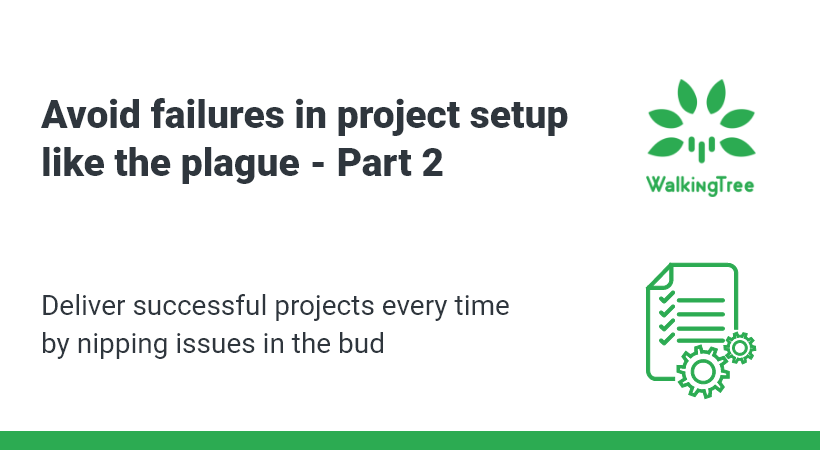

In the first part, we elaborated on the top practices to adopt during the project setup lifecycle including feasibility analysis, milestone identification, Agile project planning & execution, project code review, and others. In this concluding part, we will elaborate on more project setup strategies to combine with those practices to optimize your project success.
Irrespective of the size, complexity, and purpose of your project, you need the best possible approach for project set-up from day one to cater to your ultimate project goals as well as align with your overall business goals. Nearly 90% of the large and complex projects fail every year and not adopting proper project practices is one of the main reasons behind that. Setting up the project right and following the proper practices can not only ensure better results but helps you optimize your time and resources. And in this blog, we will guide you through the top project set-up best practices to excel in this.
Unraveling the Keys to Adopt the Best Project Set-Up Approach
1. Define life cycle and milestones
For each group involved in the project, organizations must map and define phases, deliverables, critical milestones, and sufficient criteria. A project’s life cycle is divided into four phases: concept, planning, implementation, and closeout. Project management is employed in almost every industry and company. The adoption of four basic phases results in a shared understanding of projects that span industries.
Every organization divides its projects into phases in its own unique method. These inform stakeholders about how project work is carried out at that firm. The project’s technical processes may determine what stages are termed, how many there are, and how they connect to one another. Some are referred to as Pre-contract, Contract, Construction, and Turnover, while others use the terms Start-up, Analysis, Design, Develop, Implement, and Post-implementation Audit. The most significant advantage of developing and identifying phases in a project life cycle is that it provides a standard procedure or technique for project work that everyone understands.
2. Ensure stable requirements and scope
Project requirements, objectives, and scope must be established and stabilized early in the project life cycle for effective project management. The requirements for the project should be determined during the concept phase. Answering the following questions ensures that all stakeholders are on the same page about the needs and scope:
- So, what are the plans?
- What kind of product, service, system, or achievement will be created?
- What are the objectives and advantages?
- What will be the criterion for success once the goal has been met?
- What are the expected outcomes?
- What will be the product’s, system’s, or results physical manifestation?
- What are the performance benchmarks?
- How are deliverables’ validity, utility, correctness, and completeness determined?
- What restrictions affect performance, time, and cost?
- What are the product’s cost, time, and performance constraints?
- What are the project’s priorities, resources, and interface constraints?
- What dangers should you be aware of?
- Are there any dangers in the project or the product? What effect does magnitude and complexity have?
3. Define organization, systems, and roles
Project managers, functional managers, and team members must all have defined roles in any organization. Everyone’s commitments must be defined. Interpersonal and leadership abilities are required. To be successful, you’ll need a system of communication and team participation.
The functional form on one end, the pure project form on the other, and the matrix somewhere in between, organizational forms for project management can be seen as a continuum. The functional form of an organization is one in which work activities are divided into similar specializations and the organization is directed toward functional groups. The employees are divided into groups based on their areas of expertise. Projects are still used in functional organizations, but the scope of the project is restricted to the function. A project organization is defined as one that is organized around projects and has project managers with official authority over the employees who conduct the work. The employees are divided into projects and project managers, who have a large lot of autonomy and authority.
A matrix organization combines project and functional organizations. The matrix organizational structure is commonly found in businesses that have a number of projects running at the same time, none of which are large enough to warrant the creation of a separate project organization. By definition, the matrix organization is a compromise, attempting to balance the needs of the project manager and the functional manager. The project manager’s relationship with the functional users may be “strong,” with the project manager assuming a supervisory role over the functional personnel for the duration of the project. It could also be a “weak” one, in which functional personnel receive work direction from the functional supervisor. In the “weak” category.The project manager in the “weak” position acts as a coordinator, working via the functional manager rather than directly with the functional people.
The function manager’s role is to provide functional policy, procedural guidance, qualified staff, and maintenance of technical excellence. The functional manager is responsible for the HOW and WHO project. That is, how the engineering work will be conducted, the choice of technology, standards, norms and disciplinary procedures needed. The functional manager is responsible for the person who will be assigned to perform the project’s work on behalf of the department, department, or functional group.
The project manager’s role is to plan, organize, staff, evaluate, direct, control, and direct the project from conception to completion. The project manager is responsible for the WHAT and WHO of the project. That is, what project work will be done to meet the scope, cost, and quality goals of the project, and when will the work be done to meet the project schedule goals? . However, when it comes to project cost goals, the function manager is responsible for estimating the cost of the project work, and the project manager is responsible for determining if the project budget allows for it. or not. In the event of a conflict between a project manager and a functional manager, both must be able to resolve their conflict and arrive at a fair resolution that benefits their business and gives them credit. responsibility for their profession and industry.
Project managers perform many leadership functions in directing project activities. These include planning, organizing, monitoring, and controlling project activities. When selecting a project manager, several factors should be considered in developing the criteria. These factors include communication, technical, and political skills. It is possible that the project manager is an expert on the underlying technology in the project, but that is usually not the case. Although a generalist, a project manager must have the expertise and credibility to lead a team of technical experts.
To successfully manage their initiatives, project managers require accurate data. The volume of data that needs to be captured will determine how a computerized corporate information reporting system is used and interacted with in any firm of any size. These systems may or may not have been created with the project manager’s requirements in mind. If these systems have vulnerabilities, they may need to be fixed. As a result, a project manager must be familiar with the needs of a project information reporting system.
4. Planned commitments
Plans must be founded on the organization’s process capacity rather than wishful thinking. Wishful project timetables are frequently built on a “house of cards” where necessary resources are not available. Plans must address all parts of the project management process, making them more than just timetables.
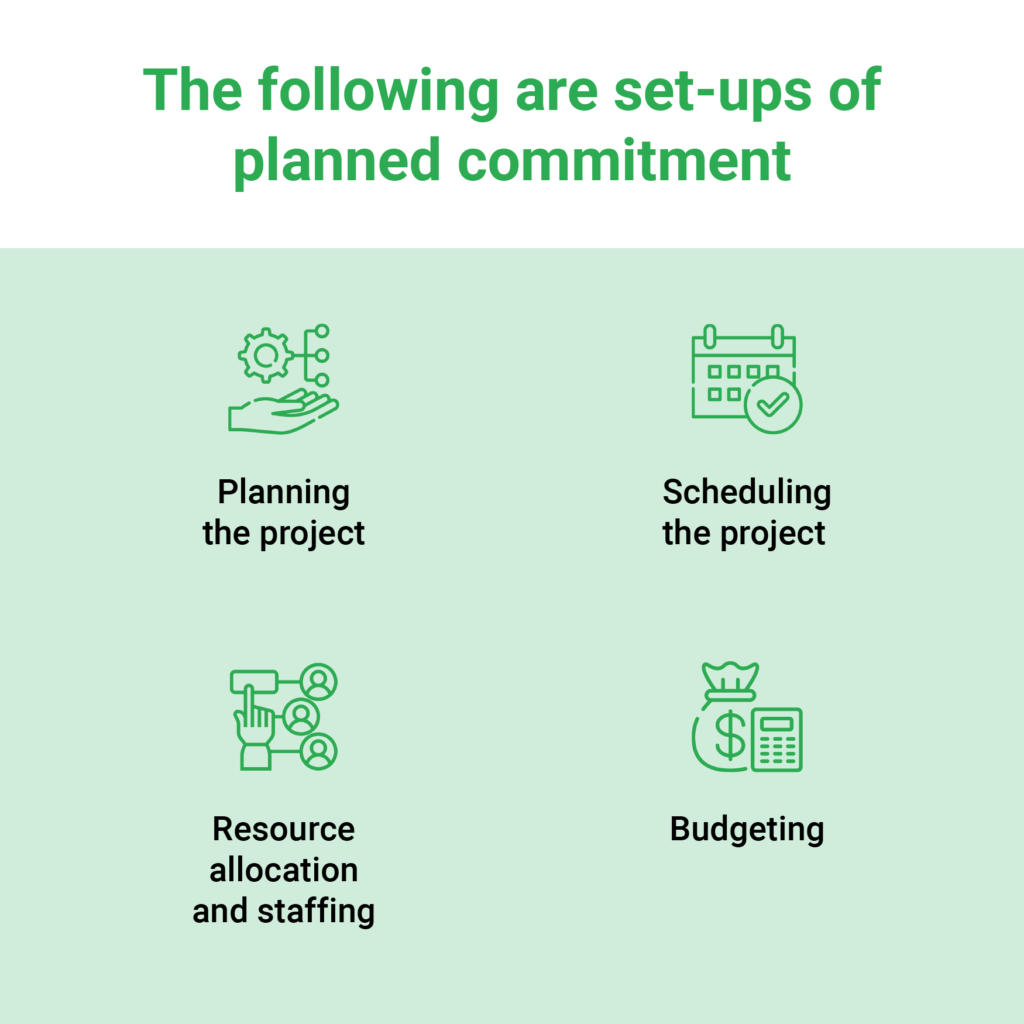
It’s never too early to start thinking about your planning. Even if there isn’t enough information to create a formalized strategy, planning must continue. The goal of planning is to lessen the unknowns and uncertainty so that the project has a better chance of success. If there isn’t enough data to make a plan, the strategy should be to figure out how to learn enough to plan the next stage.
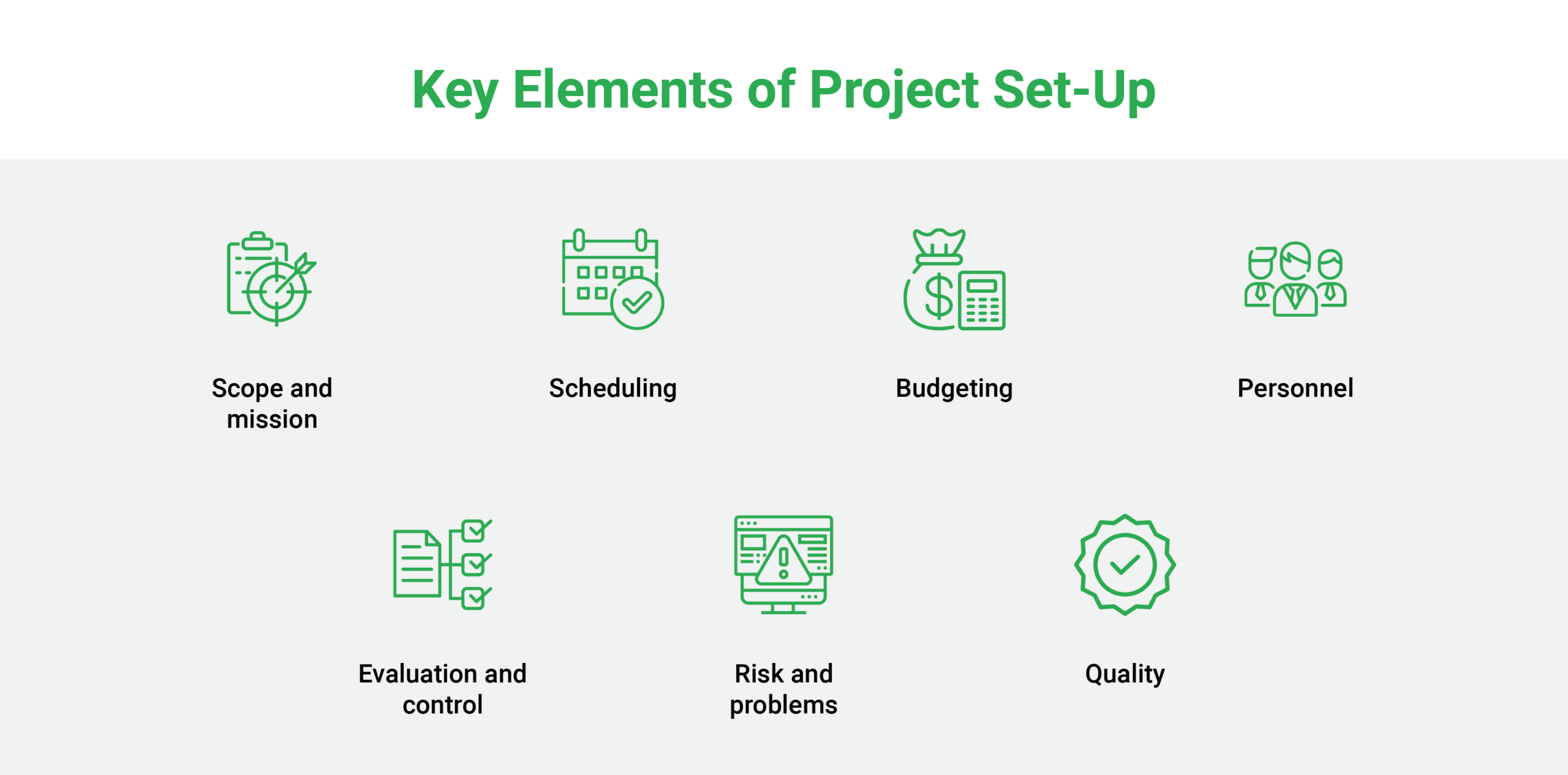
A project set up consists of the following elements:
- Scope and mission – It establishes project limits, goals, and objectives. This contains the business case and serves as a foundation for making decisions.
- Scheduling – To build the project schedule, it is necessary to evaluate activity sequences and durations, as well as resource requirements.
- Budgeting – It’s the process of calculating a total cost estimate based on individual job components. This can then be used as a cost baseline against which project performance can be measured.
- Personnel – Its requirements are determined by the project’s activity. Determines project team member recruitment, selection, and training.
- Evaluation and control – It is necessary at all stages of the project. To provide a thorough view of the project’s development, a system must be in place.
- Risk and problems – Identification, assessment, and management must all be done methodically. Risk management is proactive rather than reactive, and it entails the control of probable future events.
- Quality – it signifies that the set performance criteria will be met.
[/vc_column_text][vc_column_text]The planning process would not be complete without scheduling. Network diagrams and Gantt charts are created using project requirements and the WBS. Realistic schedules and project management reports are determined using the Critical Path Method (CPM) and the Program Evaluation and Review Technique (PERT). Schedules are compressed using fast tracking and crashing.
Project cost, agenda and overall performance are noticeably dependent on having assets. The challenge proprietors must offer the essential assets to guide the challenge and to preserve ongoing surveillance over using the ones assets. Project making plans estimates the assets to tasks. However, there must be some flexibility in how assigned resources can be used most effectively.
Budgeting goes beyond resource allocation to cover equipment, overhead, and contingency projections. The project budget is the project’s overall financial plan. Budgeting accuracy is crucial since it informs management about a project’s return on investment (ROI). A project budget also lays the groundwork for effective project management.
5. Do tracking and variance analysis
Exceptions to plans should be reported and remedied as part of the project management process. Regular reports and project team meetings are required for a successful project management process to notice when things are off track. Schedule slippages, cost overruns, unresolved difficulties, new hazards, and discovered issues must all be addressed as soon as possible.
Earned value is a widely used method for assessing project success. Earned value is significant since it considers both cost and schedule performance at the same time. It is the budgeted cost of completed jobs, and it denotes success. This technique can be used to create work components in the WBS or other project work units.
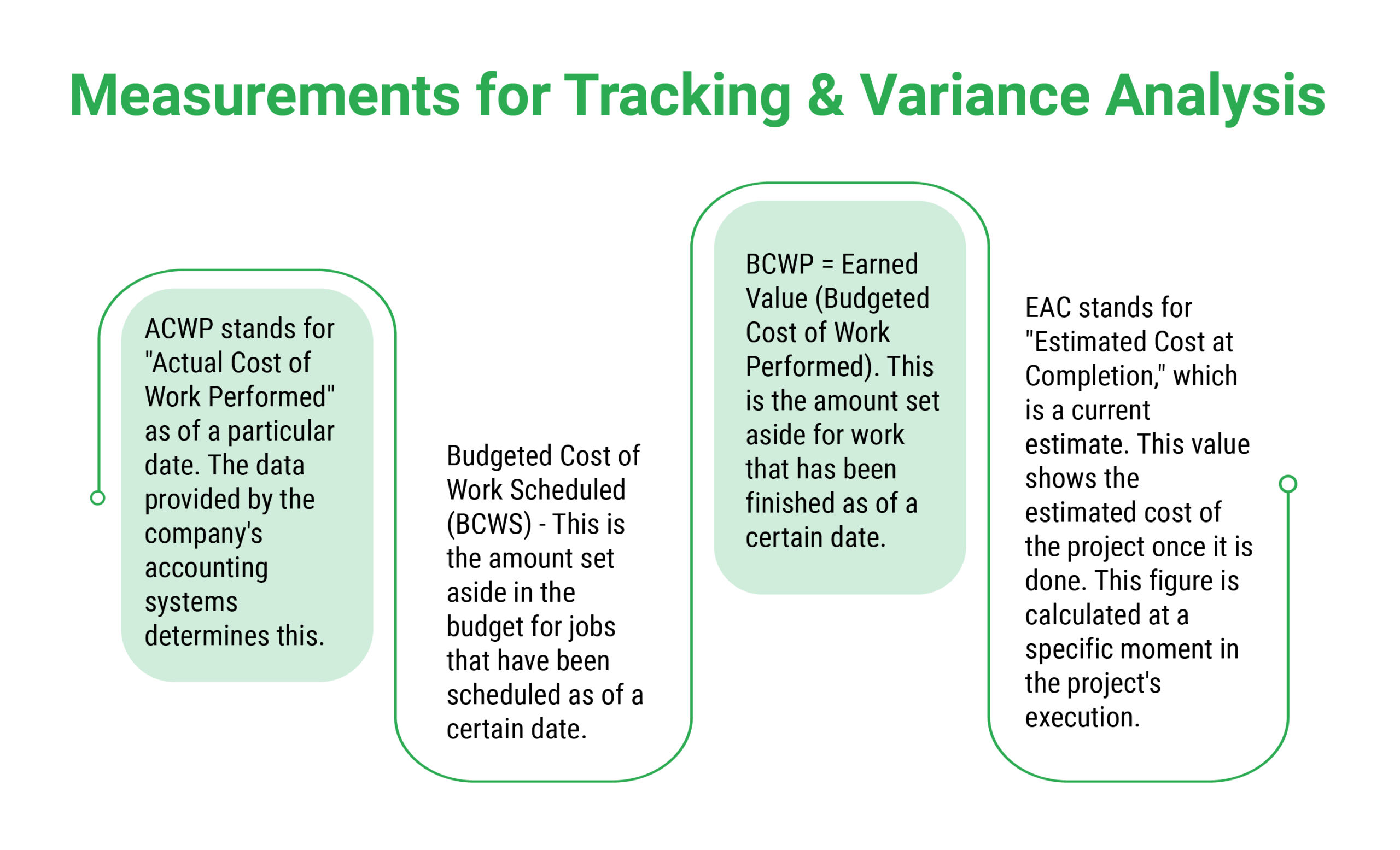 The WBS can serve as a foundation for project tracking and control. The formation of a baseline, on the other hand, is the most crucial condition for effective tracking and control. It is feasible to compare the completion status of project tasks to a baseline after one has been set for a project. The comparison could result in a variance, which is essentially the difference between expected and actual values at a given moment. The question then becomes what deviations should be assessed in order for the project manager to understand the project’s performance and make corrective action decisions.
The WBS can serve as a foundation for project tracking and control. The formation of a baseline, on the other hand, is the most crucial condition for effective tracking and control. It is feasible to compare the completion status of project tasks to a baseline after one has been set for a project. The comparison could result in a variance, which is essentially the difference between expected and actual values at a given moment. The question then becomes what deviations should be assessed in order for the project manager to understand the project’s performance and make corrective action decisions.
6. Ensure corrective action decisions
When deviations from the plan are discovered, the team or functional groupings are expected to work to get the project back on track. Corrective action taken without a clear protocol might result in a variety of results, not all of which are consistent with business goals. Increasing cost to save time, reducing scope to save time, and so on are all common choices. The project performance baseline can be reset as a last option, which may prompt the sponsor to question the original business justification. The project manager’s primary responsibility is to manage these compromises.
7. Look after the escalation and issue management
In many project situations, positive news rises to the top of the company and negative news sinks to the bottom until it’s too late. In order for an effective escalation procedure to work, concerns and problems must be addressed at the lowest appropriate level first. If the problem cannot be solved and resolved, it must be escalated to the next highest organizational level, and so on, until the problem is resolved. To escalate concerns before they become fatal to the project’s cost or schedule, a formal process should be in place, akin to a dispute clause in a contract or a grievance procedure in a contract of employment.
8. Do practice work authorization and change control
Late project changes are a major source of disruption, resulting in schedule slippage, cost overruns, flaw insertion, and rework. There must be a formal framework in place for change control and management. Changes brought on by scope creep must be resisted, and change management is required to avoid these issues.
One of the most difficult tasks for project managers is to guarantee that control is established over both the authorization of work and the approval of revisions. The project manager is at the core of communications when it comes to configuration change control. Change communications are known by different titles depending on the professional discipline or industry, such as PCN (Production Change Notice), EWO (Engineering Work Order), ER (Error Report), LTR (Lost Time Report), SR (Service or System Request), TSR (Technical Service Request), and so on.
It makes no difference what they’re called or how they’re prepared. What matters is that the project manager be kept informed so that timely choices may be made. To fully examine a change in project needs or commitments, a Project Change Request is required. Because modifications will occur, it is critical to establish a change notice log. The project manager will be able to correctly analyze requested adjustments based on the most up-to-date information.
9. Communicate effectively
Effective communication in project setup is key to project success. The project manager must keep all stakeholders up to date throughout the life of the project. During the planning phase, it is best to meet all stakeholders first and understand their expectations in order to develop a successful project plan that benefits everyone.
Studies have shown that with a functional communication plan within a project team, the overall quality of the final product is significantly increased.
10. Ask for feedback
There is never a perfect solution because there is always an opportunity for improvement. You can ensure that the final output meets the client’s expectations by incorporating a feedback loop into your project process. You can also use feedback to concentrate on learning from your mistakes and avoiding them in the future.
As a project manager, you may also solicit feedback from your team so that you can better understand your strengths and limitations and work to improve your project set up abilities.
11. Create a resource plan
There is no such thing as an unlimited budget for a project team. Even team members and project managers will frequently be tasked with managing many projects at the same time, necessitating excellent resource management. A resource plan outlines all of the available resources as well as how they are being used.
In a straightforward and intelligible format, modern project management software automatically displays how your resources are distributed and their availability.
12. Create a risk response team
Any project entails some level of risk. Effective project managers do their best to reduce project risks, but they also plan for the worst-case situation. Having an active risk response team will save you time and money by allowing you to deal with any potentially dangerous scenario as soon as it arises.
According to the PMI, 27% of companies said they always utilize elaborate risk management methods in their projects.
13. Ensure transparency in the project
Transparency in projects within the team is at the top of the list when it comes to the best project setup strategies. It is one of the key traits that distinguish agile project teams from other teams in comparable situations. Project collaboration amongst teams can be more effective when everyone is on the same page and has a clear view of the larger picture.
14. Expect and accommodate change requests
Your project’s scope can be altered, and seasoned project managers always have a change management strategy in place. The tiniest change requests can sometimes compound into a major burden for the team, leading to the project spiraling out of control. This is known as scope creep, and it was a major issue that afflicted more than half of all projects in 2018. Every single modification request from the clients should be documented as part of proper project management practice.
15. Ensure proper documentation
Maintaining a complete project log where every decision is documented is one of the greatest project management techniques. You can simply get any new members up to speed in a short period of time if you have sufficient documentation. Similarly, if you or other project managers run into a similar difficulty later, you and other project managers can refer to the project record.
You must, however, stay alert. Many project managers get overly concerned with maintaining accurate documentation, losing sight of the project’s true goal.
16. Avoid adding unrealistic milestones
To set themselves apart from their competitors, everyone wants to go above and beyond. Some project managers, on the other hand, go too far by setting unrealistic project milestones and agreeing on dates or features that are very impossible to meet. Clients may lobby for a faster completion time, and the manager may give in to the pressure.
The project and the team working on it, however, suffer as a result.
You might be able to pull it off and deliver on time if you work numerous caffeine-fueled evenings in a week, but it is counterproductive. Exhaustion has a substantial impact on the end product’s quality and has a negative impact on the team’s morale and motivation. Effective project managers recognize the limitations of team management and, on occasion, stand up to clients.
17. Review and reflect on the performance
Learning from your mistakes in order to improve yourself is possibly the oldest technique in the book, and effective project managers usually insist on making it a must. Hold a meeting where all team members review the project’s flaws and the project management tactics they’ll need to address them.
It will benefit the team, and you will have the opportunity to improve yourself. As a project manager, this exercise can also help you identify team members who may require more training in order to improve their project management skills in the future.
Over to you
There are a wide range of other project set up best practices to consider. Some of these may already be in use by you. Others may not be beneficial to your company at all. The most important element is to keep track of your own best practices, to adopt and test new ones, and to keep account of everything you do to enhance your project and set up processes in knowledge and expertise.
It’s quite likely that if you’re a project manager, you followed all of these best practices in your project, it was a success. Not only did you perform admirably, but you also assured me that your team would do even better the following time around by employing the greatest project management practices.
To know more about the optimal setup approach for your project, don’t hesitate to get in touch with us at connect@walkingtree.tech


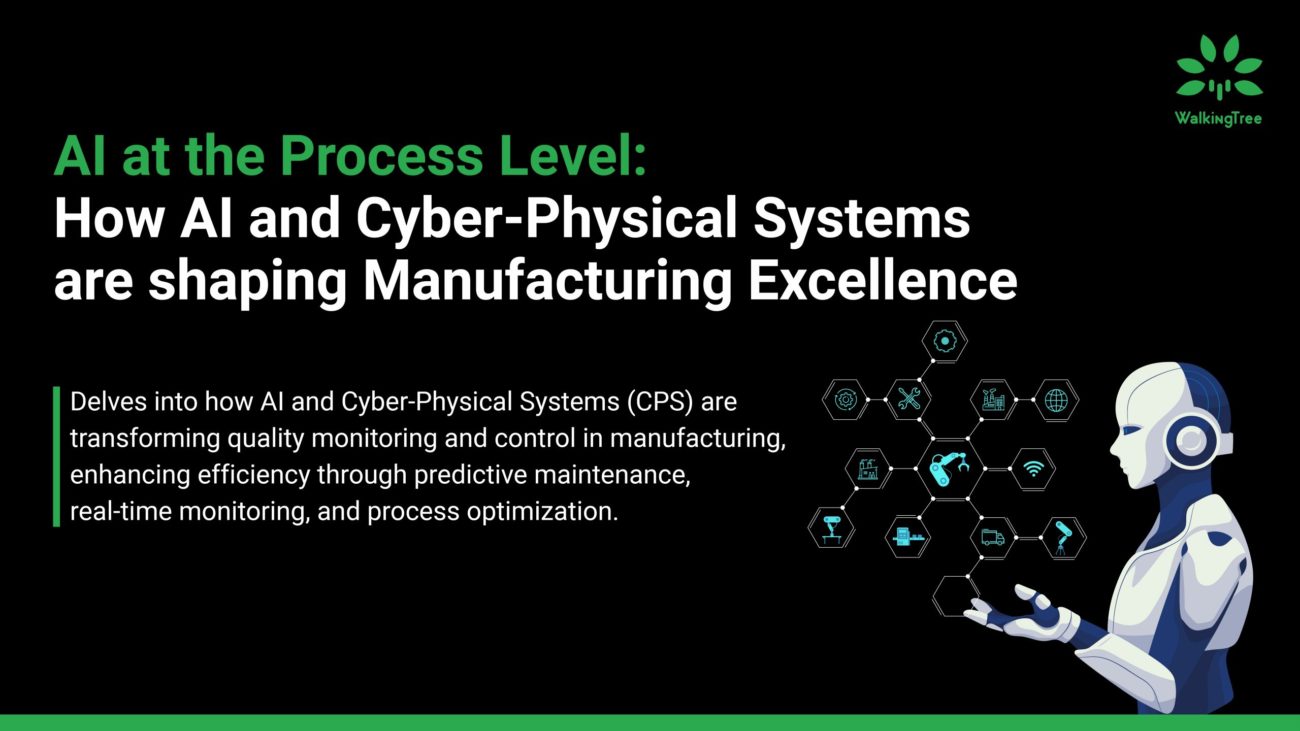








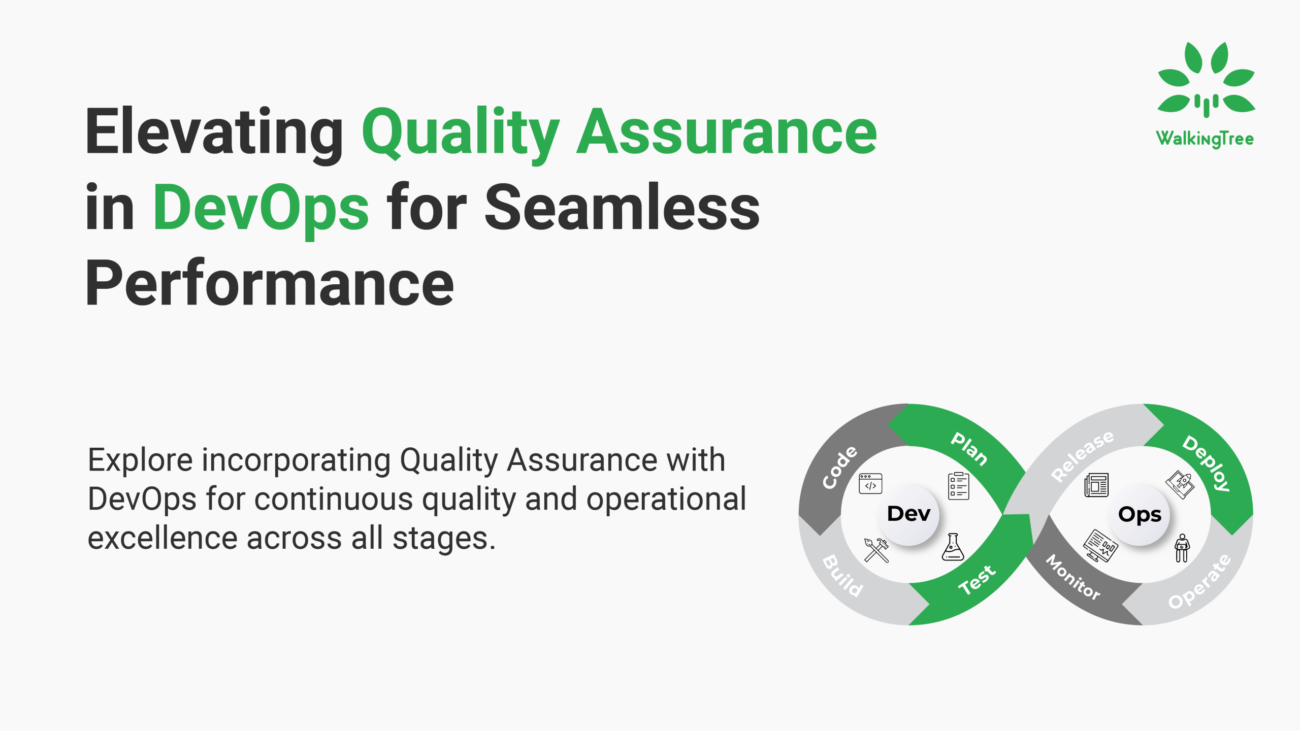

Thanks for sharing. I read many of your blog posts, cool, your blog is very good.